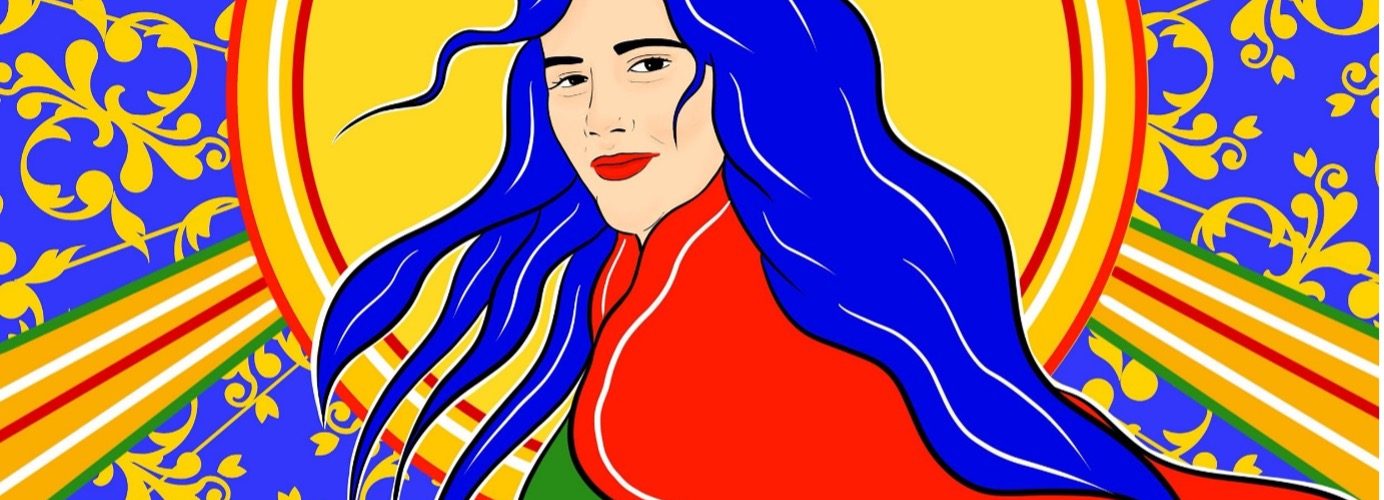Zahra Tizro
The ongoing protests in Iran were predictable after almost 44 years of the government’s monolithic rulings on the compulsory hijab and women’s rights since 1979. This is when the Islamists took power and started implementing Sharia law and the Islamification of the nation. As a result, the role of women in the family and society, in general, and the compulsory hijab in particular, have strongly affected by a government which put emphasis on the ‘emancipatory’ role of religion in its Shia version.
The term ‘hijab’ in the literature is widely used to refer to the varieties of face and head-hair coverings in Iran from pre-modern times until the 1960s, it demonstrates the ambiguous nature of its usage on the writings centring on the topic in 19th and early 20th century. Indeed, the word ‘hejab’ does not appear in the Quran in the sense of the head-covering. Some contemporary Shi’i scholars by using the principles of justice and reason challenge the necessity for wearing the mandatory hijab and employ the major jurisprudential principles of ‘time’ and ‘place’ and not religious commands. They believe there is no notion of women wearing the hijab in the Quran, therefore, women should not be forced to cover themselves and they should not be punished either – its wearing must be optional (Ridgeon, 2021).
Other Shi’i scholars employ a far broader concept of hijab as dress code and argue that a Muslim woman’s character should not be made vulnerable to aggression and the lustful gaze of unrelated men, even in their imaginations, and hijab provides such protection. Veiling or hijab in this context is the tangible measure of chastity and modesty (effat/haya). Men are obliged to make sure their female members of the family observe the rule of hijab, otherwise, they are labelled as bi-gheirat or bi-sharaf. These ethico-legal codes of mahram’yat, veiling, gheirat-effat and punishment mechanism are all in place to control women’s sexuality and their conducts and misconducts. These discourses have powerful grip on women and men’s subjectivities and selfhood in a subliminal way that they own these discourses and behave in a way to earn the respect of the family and community members to protect their social relations (Tizro, 2012).
The emergence of veiling as a key symbol of Islamic nationalism in Ayatollah Ruhollah Khomeini’s project of ‘nationalizing’ Iran needs to be contextualized in the wider history of the country. In effect, it is the mirror image of the emergence of unveiling as the flag of Persianist nationalism in the earlier Pahlavi project of nationalization (Katouzian, 2004). This was itself a reaction to the dysfunctionalities of the Qajar and the Constitutional eras.
The imposition of veiling in the Islamic Republic led to the emergence of a rising struggle between women who do not wish to observe the compulsory hijab on one side and the morality police on the other. The emergence of the phenomenon of bad veiling or mal-veiling (bad-hejabi or shol-hijabi) can be seen as a symbol of all forms of dysfunctionalities and deformities resulting from the reverse social engineering of Islamification.
The roots of the socio-political crisis in relation to hijab can be understood in the intersection of the what Malinowski called the ‘context of culture’ and the ‘context of situation’. This is captured in the confusion of associated waves of identity crisis and confused preference structures of Persianism, Islam, Western modernity (Gohardani & Tizro, 2019).
A state of bewilderment and perplexity in the interaction with perceived states of belatedness prompts the translation of three regimes of truth into three projects of social engineering, namely, ‘Persianization’, Islamization, and Modernization. In this context the whole of social life is littered with examples of projects of reverse social engineering without considering the context and the social relations that are bound into it.
Generally speaking, the ‘question of women’ and the issue of the ‘hijab’, in particular, has always been, and continues to be one of the most divisive topics giving rise to many discussions amongst (and between) rival groups and ordinary people in all walks of life, often demanding new interpretations of the holy text by modern scholars. This is a far more complex phenomenon which surpasses the simple binary of traditionalists in support of veiling and modernists advocating the modernising of many issues relating to gender relations with both a symbolical and practical focus on the removal of the hijab.
There have been two significant historical trends of women’s veiling and unveiling, both were compulsory in nature and socially/culturally engineered while being formally imposed by the authorities in power at the time. Homa Katouzian maintains that Reza Shah’s decree in 1936 on the compulsory unveiling of women “was tantamount to a decree in Europe at that time that would have forced women to go topless in public”. Katouzian’s observation is confirmed by an eyewitness, in the following terms: “Suddenly women were faced with having to go out in public unveiled. There were few options: either go out feeling “naked” or stay at home.” (2010, pp.219–20)
Reza Shah was led to believe the path to modernisation and reform of the nation passed through women’s liberation and emancipation in order to maximise their social and political participation and contribution. He used forceful measures to remove hijab and made it obligatory to appear without traditional face and body covering. Meanwhile, his son Mohamad Reza Shah continued his father’s reforms and under his rule more rights were granted to women, such as the right to vote, higher education, working even at the highest levels of ministerial, parliamentary and diplomatic rank. He introduced the family protection acts of 1967, gave the right to abortion in 1973 and enhanced a mother’s custody rights of their children while limiting polygamy and abolishing extra judicial divorce in 1975, among many other changes.
These revolutionary reforms, however, were the first dramatic encounter with modernity. They are interwoven with trauma and traumatic events with their features of being sudden, excessive, comprehensive, importunity, and irremediability can generate the sense of suspicion, fear, despair and resentment. Trauma creates rupture in the fabric of time and partitions it into a ‘before and after’ structure – here before and after veiling and unveiling or before and after the Islamic revolution.
When Khomeini took power in 1979 many of these laws were abrogated, as a result of implementing Sharia law many of the rights were granted to women during the Pahlavi era were reversed, compulsory hijab was forcefully introduced and women’s role and place in the family and society were defined and practiced according to Sharia laws. While these sudden and fundamental changes were welcomed by some women, mainly those with a religious and conservative background, others were left in a state of shock, disbelief, rage and feeling deep injustice. Yet again, another round of experiencing traumatic events is repeated in a circular manner.
The force and energy behind the most recent women-life-freedom (Zan, Zendegi, Azadi) movement can be understood in the context of the lived experiences of many women who were forced to adopt a publicly cloistered way of life based on Islamic laws against their wishes. Also, at the heart of the women-life-freedom movement lies a wish to provide sanctuary for disadvantaged, marginalised and underprivileged individuals, communities and classes suffering from injustice and inequality. The protest against the compulsory hijab and gasht-e ershad (morality police) is only one of the manifestations of this movement against the discrimination and maltreatment of women.
However, in the spirit of hermeneutic of understanding and the art of overcoming incommensurability through understanding the radical others in their own terms, we should pay attention to all voices, forces and faces. The hijab as a social phenomenon is historically embedded and realized differently within diverse institutional arrangements. The meanings attached to the concepts and lived experiences associated with hijab are subtly but significantly different in both camps – for or against hijab. Those who favour it and support the government’s gender policies, in general, and the compulsory hijab in particular, argue that by de-sexualising women’s bodies, using hijab, women’s mobility and their access to the outside world were/are enhanced. They believe that the gender segregation policies, implemented immediately after the revolution at universities and work places, gave women and girls (most particularly from rural areas) greater chances to travel independently to other cities. This, in turn, had a significant impact in increasing the number of women graduates and women joining the workforce.
In this context, by endorsing hijab, women and girls from most conservative families were allowed to have better choices in life which could not be envisaged had it not been for the immunity, liberty and mobility that wearing hijab provides. Subsequently, by enhancing their financial situations their power, agency and status in the family and society have grown to a large degree, thereby emancipating these women in many ways.
In criticising the recent movement, some of the hardcore religious figures have put the blame on the previous government (of President Hassan Rouhani) relaxed policies in relation to ‘bad hijabi women’. When hardliner candidate Ebrahim Raisi won the presidential election, there were calls for tougher polices and punishment against those who do not observe the rules and regulations. Immediately after coming to office, a number of bills regarding population growth and family protection were conditionally passed.
These placed more restrictions on women’s reproductive health programmes such as the ban on antenatal screening tests and abortion rights. The budget for the centre for ‘inviting to vice and virtue and forbidding the wrong’ (amr-e be maroof va nah’ye az monkar) was increased and was intended to put more pressure on women and girls with poor hijab in public. Currently, the law in relation to hijab wearing is stated under article 639 of the Islamic Penal Code of Iran: Article 638- Anyone who explicitly violates any religious taboo in public beside being punished for the act should also be imprisoned from ten days to two months, or should be flogged (74 lashes). Note- women who appear in public without a proper hijab should be imprisoned from ten days to two months or pay a fine of 50,000 to 500,000 Ryal.
Most recently, four months since the women-life-freedom movement started, Supreme Leader Ayatallh Ali Khamanei addressed the events and invited his supporters not to employ strong measures against women with lax hijab (or as he called it zaeif-al-hijab): “The hijab is a religious and inviolable necessity, but this inviolable necessity should not mean that someone without a full hijab should be accused of anti-religion or anti-revolutionary.” He advised them instead of using batons and violence against young people, whom as he said are under the influence of worldly temptations, they have to start articulating their perspectives in different shapes and forms (jihad-e tabeen) to reach consensus.
There is some speculation about how these comments would be perceived or interpreted by legislators and law enforcement, but there is a slim chance that the rules and regulations regarding hijab would undergo substantive changes as expected by those who demand reforms. This depends on different interpretations of what is perceived a ‘proper hijab’ by the legal system and morality police.
As both veiling and unveiling are the outcomes of reverse social engineering, lacking an adequate and irreversible level of emergent legitimacy and consensus, their corresponding institutionalized forms of Islamic and Persianist nationalism were beset by debilitating forms of dysfunctionalities. The focus should be on the urgency of reaching consensus on contemporary issues concerning Iranian daily life, more particularly, women’s clothing and their rights. For centuries, knowledge production predominantly was the terrain of men and their understanding and interpretations of the holy text and religious narratives (ahadith) about women had a profound impact on women’s lives.
Nevertheless, we are witnessing the emergence of competent Iranian female scholars producing significant and valuable scholarship in a range of scientific fields. Meanwhile, we need to offer a detailed and scholarly analysis of the workings of the religious orthodoxy. This can be achieved through rigorous research not in a combative way but with a compassionate spirit to explore the capacity of Shi’i jurisprudence to offer a more inclusive, pluralistic and flexible interpretation of Islam and engage more in this jurisprudential venture. Women’s voices within hawza ilmiyya (religious schools) should be heard and considered in order to offer a fuller, inclusive and dialogical approach. To establish gender equality in all walks of life, the riverbed of thought (in Wittgenstein’s metaphor) must be shifted.
A wholesale change in the structures of the dominant hegemonic masculinist discourse is required. We need to see the emergence of a society of “inside outsiders” inside the larger society who practice and believe in gender equality encompassing all aspects of life. Through ‘increasing the sites of resistance’ to privileged knowledges, women-life-freedom movement has the potential to offer polyvocality and a smooth emergence of viable alternative discourses embedded and rooted in the ‘Background’.

Zahra Tizro is a Senior Lecturer at the School of Psychology University of East of London and the author of Domestic Violence in Iran: Women, Marriage and Islam (Routledge, 2012). Her research interests focus on gender and violence from a cross-cultural perspective. Twitter: @ztizro
Header Image Credit: Roshi Rouzbehani
TO CITE THIS ARTICLE:
Tizro, Zahra 2023. ‘The Political Psychology of Veiling / Unveiling in Iran’ Discover Society: New Series 3 (1): https://doi.org/10.51428/dsoc.2023.01.0005




